I haven’t been playing much that’s new recently, so after a gap of several years I have decided to do another one of my concept pieces whereby I play through an older game series to see how it evolves over time. Unlike my prior attempts, because we are currently in the middle of a pandemic, and more importantly because I have half of the games already played and written up, I’m 90% sure I’m actually going to finish this one. The series in question is the point and click adventure games made by LucasArts in the late 80s and early 90s, and the reason I decided to do this is because I haven’t actually played most of them — I haven’t played anything before Monkey Island, and I haven’t played Full Throttle, or Sam & Max, or Indiana Jones And The Fate Of Atlantis. So this is going to be just as much a learning experience for me as it is a trip down memory lane, as I fill in some missing gaps in my gaming history and hopefully learn a little something about the evolution of adventure games in the process.
To avoid confusion about the developer name: I know that they were formed in 1982 as a division of Lucasfilm called Lucasfilm Games and didn’t take on the LucasArts name until 1990, but for consistency I will be referring to them throughout this series as LucasArts.
Also, a quick note on versions before we get going — for most of the early LucasArts titles there are multiple different versions available: the original EGA release and a later VGA rerelease. Zak McKracken and Maniac Mansion were also both originally released for the Commodore 64, and the C64 versions look even more primitive than the MS-DOS ones. For the start of this series I’m going to be playing the EGA MS-DOS versions emulated through ScummVM where possible, as keeping things to a single palette and a single platform should make it much easier to track how the visuals and game systems are evolving over time.
——————————–
There are some old classics which, when you play them, have aged like a fine wine. Sometimes it’s because they’re just that good, that the developers somehow managed to catch lightning in a bottle and created something timeless and lasting. Much more often, though, it’s because there’s been little advancement in the genre of which they are a part — or that the genre simply died completely — and so those old classics still represent the peak of the artform.
Most of the fondly remembered classics from the Golden Age of the Adventure Game (1988-1998) fall into the second category. A few, a very, very few, can be counted as part of the first. Maniac Mansion, however, falls squarely into a third category: it’s the one marked “Of Academic Interest Only”.
As far as the history of the adventure game genre goes, Maniac Mansion is certainly a very important one. You have to remember that prior to Maniac Mansion nearly every single adventure game in existence was designed to be played without a mouse, and so used a text interface where you had to manually type in your commands and interactions, with no help from the game to tell you what those commands and interactions could be. This led to a lot of frustration and wasted time as the game repeatedly told you “I don’t recognise that command” because you hadn’t phrased the command exactly as the game wanted it; it was a clash between human generalisation (a human thinks that USE LIGHT SWITCH means the same thing as TURN ON LIGHT SWITCH) and machine precision (the text parser doesn’t). What made things much, much worse was that these pre-Maniac Mansion adventure games had a hugely bloated range of interaction verbs (such as PUSH, PULL, GIVE, USE etc.) compared to the streamlined set of nine that the later LucasArts titles finally settled on, and so finding the specific combination of verbs and items that the game wanted you to use in order to progress often made you want to SMASH HEAD into BRICK WALL.
Maniac Mansion changed all of this. The developers behind it — in particular Ron Gilbert — rightly wondered if there might not be an easier way of doing things, one that could leverage the increasingly-common mouse interface for a more intuitive point-and-click control scheme, and so Maniac Mansion is the first game ever to have the available interaction verbs visible on screen at all times, along with the now-familiar system of clicking on the verb PUSH and then on the doorbell on screen in order to PUSH DOORBELL. This drastically lowered the barrier to entry by reducing the amount of information the player had to keep in their head at any one time — no more playing with the game manual propped open next to you so that you could refer to the command sheet inside — and also brought the action of playing the game much closer to the on-screen representation of it, as it’s a much more pleasant thing to click on a visual representation of a doorbell in the environment to interact with it than the screaming artificiality of typing words into a text box. It was a huge, revolutionary improvement, one that was so impactful on the player’s enjoyment of the game that within a couple of years all adventure games had adopted an identical control scheme.
But they didn’t get it exactly right first time.
Since I’m coming at it from the wrong end of the next decade of adventure game evolution, playing Maniac Mansion in 2020 is rough. This is partly down to it being essentially a prototype and a launching pad for LucasArts’ actual golden years which came a little later; there are some quirks of the game’s design that were not repeated in later LucasArts games once they’d gotten their basic blueprint nailed down. However, it’s mostly down to the interface, which in this initial raw form is rather awkward and fiddly to use compared to what came later. Gilbert and co. made the great conceptual leap of first putting the interaction verbs on screen, and then boiling them down to a much more manageable number in order to make them all fit — but they were too conservative here, and didn’t go far enough. UNLOCK, TURN ON and TURN OFF all have their own dedicated verbs despite USE also being present and having all of these verbs implicit in it. There’s also the bafflingly specific FIX, and while Maniac Mansion does at least allow a little leeway in which verb you use (I never had to actually use FIX since I always went for USE instead) it allows nowhere near enough, demanding that I TURN ON the light instead of USING it. READ is used here instead of the later LOOK, which is very unclear — what if I want to examine something that doesn’t have any writing on it? — and perhaps the worst offender is a dual fuckup shared between the mouse interface and the verb selection: the WHAT IS verb.
WHAT IS is the thing that really made me realise just how much of the interface in later LucasArts adventure games I’d taken for granted. You see, Maniac Mansion doesn’t have that context-sensitive mouse-hover tooltip behaviour that featured in all of their games post-Monkey Island, where hovering the mouse cursor over any on-screen interactable item popped up the name of that item in your command bar so that you could quickly figure out where the points of interest were in your current environment. Or rather, it does have it, but only if you toggle WHAT IS on first. You can wave your mouse around all you like in Maniac Mansion and you won’t learn a thing; you won’t see that the thing that looks like a peephole on the front door is in fact a doorbell, or that the gargoyle figurines on the staircase are interactable objects that can be used to open a locked door down to the basement. You’ll only figure this stuff out if you do that sweep with WHAT IS toggled on, and the moment you move your mouse away to select a new verb to use with the interesting thing you’ve found with WHAT IS, you lose the WHAT IS information and will have to go hunting for the interaction point again by randomly clicking around the area where you saw it with WHAT IS. The useful thing that you can do with WHAT IS is to click on the thing with WHAT IS toggled on, which locks it into your command bar as the target for the next interaction, at which point you can then safely switch out WHAT IS for another verb and then click on the command in the command bar to execute the new version. This is, however, ridiculously unintuitive, awkward and kludgey, and the WHAT IS functionality not being the default mouse cursor behaviour is the thing that I missed the most from subsequent LucasArts titles.
The clumsy WHAT IS functionality isn’t helped by Maniac Mansion’s visuals, which are incredibly primitive. This is partly down to the limited colour palette available at the time — Maniac Mansion was developed for the low-resolution EGA palette available on the Commodore 64, which offered a mere 16 shades of colour that veered sharply between “ghastly” and “garish”, with nothing in between — and partly down to the traditionally-trained artists and animators at LucasArts not being particularly well-versed in how to draw pixel art on a computer using this limited set of colours. They got a lot better at it later, with both Loom and Monkey Island being a quantum leap forward in terms of visuals despite being lumbered with the exact same EGA colours, but Maniac Mansion has huge problems with perspective, proportions and detail. It’s not a “this game is old and ugly” problem, because that kind of goes with the territory when you’re playing something from 1987 designed to run on a potato with 64KB of memory. It’s rather a readability issue: because there’s so few colours available, and because the artists haven’t figured out how to draw things properly in EGA yet, there’s zero visual cues available to distinguish between things that you can pick up, things that you can interact with, and things that are simply part of the background scenery. Because there’s no help offered by the game’s art you are forced to sweep every screen with WHAT IS to make sure you haven’t missed anything, but even this is fraught with issues since they also haven’t yet realised it’s a good idea to make the interaction area for a small object larger than the object itself so that the player doesn’t have to go pixel-hunting; there are some interactable points of interest in this game which are absolutely tiny, and which I had trouble finding even with WHAT IS toggled on.
So despite Maniac Mansion inducing a seismic shift in what adventure games looked like and how they were played, the actual mechanical process of playing Maniac Mansion itself is awkward and uncomfortable, with far too many clicks required for simple actions that would have taken less than a second in later efforts. As an adventure game itself though, Maniac Mansion is…
Yeah, it’s still kind of bad, I think. But at least it’s interestingly bad, even thirty-three years later. There’s absolutely no flavour to the game, with the conversation system that ended up defining LucasArts adventures totally absent from this initial attempt, and the barest of the bare minimum of incidental dialogue from the protagonists. There isn’t even any music, and sound effects are so rare they’re genuinely startling when they occur1; most of my time spent playing Maniac Mansion was accompanied by nothing more than dead silence. Most of what little story the game has is told via cutscenes that fire at timed intervals: mad scientist Dr Fred and his family are under the influence of a magic meteor from outer space and have kidnapped a local girl called Sandy in order to… transplant the meteor consciousness into her, or something, so Sandy’s boyfriend Dave enlists the help of two of his high school classmates to enter Dr Fred’s mansion and rescue her.
Which high school classmates come with him is the interesting part, as you get to pick two from a selection of five at the start of the game, each of whom has special abilities and can approach puzzles in unique ways; school nerd Bernard is good at dismantling and fixing electronic equipment, while punk rocker Razor plays a variety of musical instruments and can use this skill to impress the rock-wannabe Green Tentacle. You control one character at a time but can switch between them at any time, and there’s a few puzzles that involve pushing a button or creating a distraction with one character and then quickly switching to a second character to go through a door or push a button or descend to the bottom of a swimming pool that’s being used as coolant for a nuclear reactor. The reason you occasionally need to create a distraction is because while Dr Fred himself is busy in his basement laboratory with Sandy and the meteor, his immediate family are still present in certain areas of the mansion and can move around it in response to certain events that happen on a timer; if they see you they’ll chase you, and if they catch you they’ll throw you into a dungeon. The dungeon is easy to escape (except for having to battle the inadequacies of WHAT IS, obviously), but then you have to spend a couple of minutes getting back to where you were, which is annoying to say the least. In order to pass through the areas where the family members are present you need a distraction, which requires two characters working together.
Now, I don’t think the way this stuff is implemented in Maniac Mansion is very good. Even at its best the switching around is far too fiddly, and having different characters be good at different things but only having some of them present in the game means there’s a high prevalence of items that are useless on this particular run because you didn’t bring the characters with the skills to use them. Having three characters on the go at once already adds a distressing amount of non-linearity to the game; adding a bunch of red herring items just increases the time taken to figure out puzzle solutions to the point where I gave up two hours in and resorted to a walkthrough. When I was reading this walkthrough I noticed an awful lot of “don’t do this otherwise you’ll render the game incompletable with that character” warnings; Maniac Mansion in general is okay at trying to stop you from getting into dead ends, and I imagine at the time it was a welcome tonic after playing dozens of adventure games that would just flat out kill you if you did the wrong thing. The complexity of the game still means LucasArts couldn’t quite eliminate all of those dead ends, though, and it’s also still possible to die in Maniac Mansion by causing the mansion to explode if you don’t complete certain tasks within a time a limit, which struck me as something of a dick move.
Otherwise the thing that bugs me most about Maniac Mansion is the fact that it’s pretty much a 1:1 translation of a text adventure into a graphical format – it has very little in it that’s not purely functional, with none of the visual jokes or amusing comments from the protagonist that later LucasArts adventure games became known for. Despite Ron Gilbert’s avowed hatred of Adventure Game Logic Maniac Mansion still contains a hefty dose of Adventure Game Logic itself, even if it does try to lampshade some of it via the timed cutscenes which flag up (for example) that a critical keycard item is in fact hidden underneath Cousin Ed’s pet hamster. I think much of this is because they’re still finding their feet with the humour too; Maniac Mansion goes for the wacky, zany tone of mid-80s teen comedies and cartoons, except its cartoon logic is sometimes so out there you wonder how they ever thought anyone would arrive at the solution through anything except trial and error. Some of their other games also made the mistake of compromising the puzzle logic in the name of a throwaway joke (the monkey wrench puzzle from Monkey Island 2 still comes in for regular criticism 29 years later) but what’s particularly annoying about Maniac Mansion is that the humour isn’t even good, it’s just over the top and mostly falls flat on its face.
Still, while it’s somewhat painful and not particularly enjoyable to play today — and I really wouldn’t recommend playing Maniac Mansion to anyone unless it was for research purposes — I still think that the few hours I spent playing through Maniac Mansion were worthwhile. It was LucasArts’ first proper adventure game2 and set a baseline for my expectations of what comes next: they have the concept for their interface but the implementation isn’t quite there yet, the humour mostly misfires but does show glimmers of promise, and having multiple protagonists active at once is definitely an unusual idea for the adventure game genre to be playing around with this early, even if it doesn’t really work here either. It’s telling that LucasArts took a second shot at Maniac Mansion six years later and ended up making the second or third best adventure game ever: Day Of The Tentacle. The difference was those additional six years of experience and accomplishment, and it’s going to be extremely interesting to see how their games evolve between now and then.

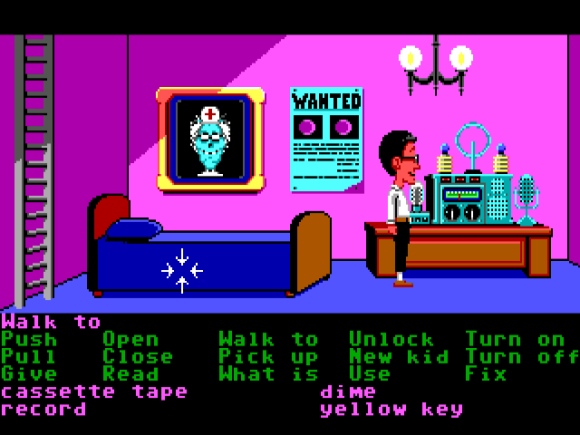
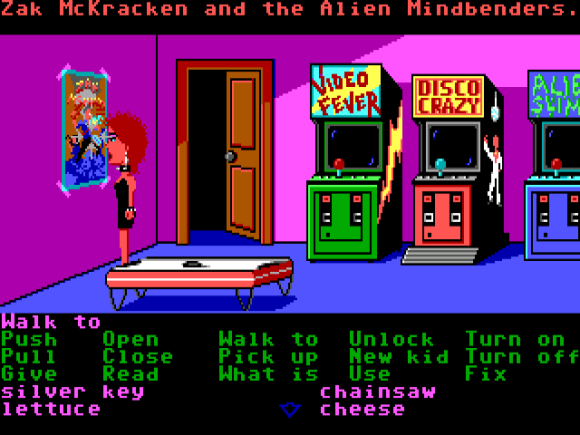
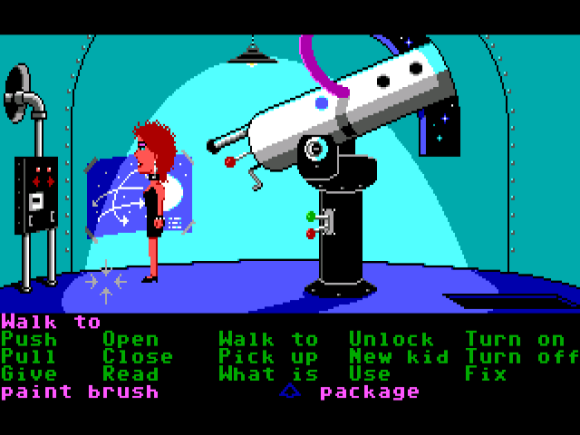
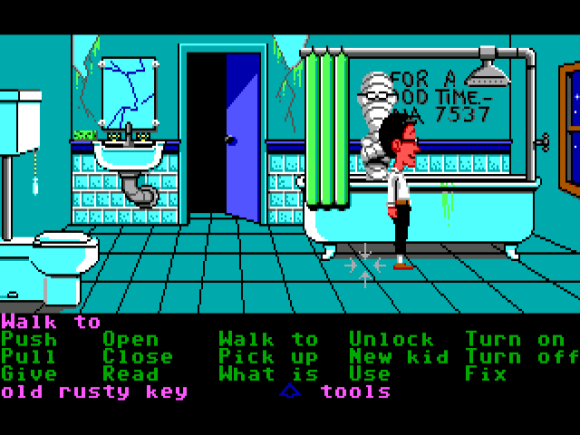
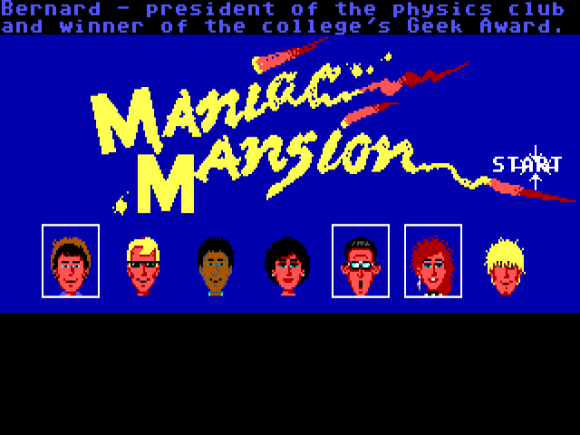
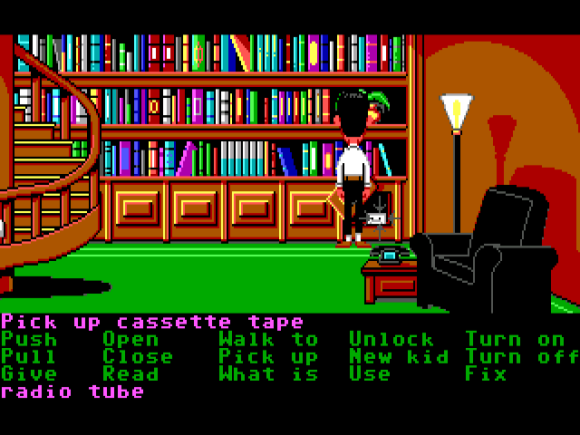
I was one of those kids that Day Of The Tentacle was my entry point to LucasArts adventure games, and I played Monkey Island shortly thereafter. I remember when I stumbled upon Maniac Manson on Ed Edison’s computer in the game, I tried for hours to figure out how to play it. And that is always the dilemma as you brought up in your introduction: there are some great old games with great old ideas, but there are also the later building and improvement of those ideas. At some threshold, the struggle required to enjoy a game just isn’t worth it anymore. Which always saddens me to admit as someone to determined to enjoy every game in every great game series. Something keeps drawing me back to wanting to beat my head against Maniac Mansion, maybe one day I’ll consult a guide to get through it.
I really wouldn’t recommend it. The useful thing Maniac Mansion rammed home for me was realising just what a quantum leap Monkey Island was over their previous games — LucasArts didn’t just start out knowing how to make good adventure games and needed several goes to get it right. But playing Maniac Mansion for its own sake? I don’t think you’d get much out of it.
Hey there, long time, first time. Just wondering, you mention that DOTT is the second- or third-best adventure game ever. What’s your number one? Adventure games are rarely reviewed on this site and are what got me into gaming way back in the day, so I’m kind of curious. Thanks!
Well, I’ll go over this in a little more detail when I get to them, but for a long time I would have said it was DOTT. The further away we get from 1997, though, the more I find that Curse Of Monkey Island is aging spectacularly well – incredible art, incredible music, and some fantastic jokes that are actually written to be voice acted. The only weak link is that the puzzles are a little more scattershot than DOTTs. I didn’t like Curse all that much at the time, but subsequent replays have really rammed home that it was the pinnacle of the 2D adventure game in terms of LucasArts’ mastery of the craft, which is ironic because it was also the last one LucasArts made.
[…] you have been following these posts for a while, you’ll know that I started with Maniac Mansion, which was the first adventure game to move to a mouse-driven interface by putting its action verbs […]